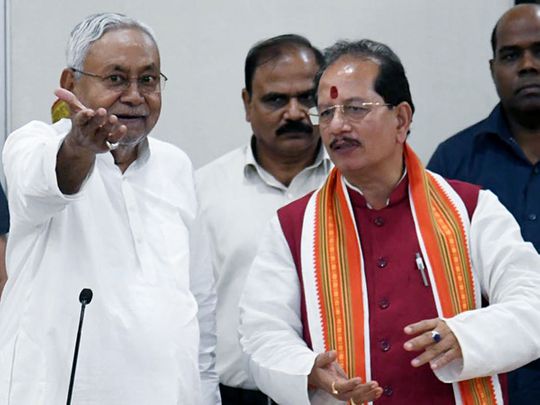
Will the weight of caste continue to hang around India’s neck like the proverbial albatross? Going by the recently released Bihar caste census, the answer, regrettably, is yes. The caste survey conducted by the Opposition-ruled state government shows that 36 per cent of Bihar’s population have been classified as Extremely Backward Classes (EBCs) while 27 per cent are Other Backward Classes (OBCs). Together, they make up 63 per cent of Bihar’s total population of 130 million.
The 63 per cent figure is magical for those demanding higher caste-based quotas or reservations in education and employment. The current ceiling in most parts of India, as fixed by the country’s Supreme Court, is 50 per cent. This includes the 22.5 per cent for Schedule Castes and Tribes and the 27 per cent for OBCs. The Opposition demand is that this ceiling of 50 per cent be removed and reservations for the so-called backwards be raised at least to 63 per cent, in proportion to their population in the state.
The survey has already unleashed yet another bout of the politics of competitive backwardness in India. As one wag put it somewhat cynically, the forward among the backward will clamour for a greater share of the national pie, hiding behind the other backwards beneath them. The greater the number of the latter, the more the tiny sliver of the former, officially known as the creamy layer, stands to gain. But more practically speaking, many other states, especially those ruled by the Opposition, may follow suit, publishing their own caste data. In turn, this will not result in similar demands for more reservations in the state services, but also the demand that the Centre also increase caste-based quotas.
Opposing views on caste census
How quickly this has become a national issue can be gauged by Opposition leader Rahul Gandhi of the Indian National Congress, demanding “jitni abadi utna haq” — as much the population that much the right. Prime Minister Narendra Modi of the ruling Bharatiya Janata Party (BJP) was quick to retort that the only caste he recognises is that of the nation’s poor. That just about sums up two opposing views on the issue, although it is likely that the BJP, too, despite its more idealistic pronouncements, will also succumb to the political pressures of caste appeasement.
Before proceeding, let us look at why caste data has become so important. Caste and religious data began to be collected by the British colonial government ostensibly to help them govern their hugely diverse and complex Indian subjects better. But this data was also used effectively to promote the policy of divide and rule, all the way to the partition of the subcontinent along religious lines.
A prelude to this dismemberment was the demand by the Muslim League for quotas in proportion to the Muslim population in all elected bodies. Upholding the principle of one person, one vote, the mainstream national party Congress turned this down. There were similar demands for separate electorates from other sections of the Indian political spectrum, including the depressed classes, led by Dr B.R. Ambedkar. Though Mahatma Gandhi fasted against this demand, reserved seats for Schedule Castes and Tribes became part of Indian electoral democracy after independence. As did caste-based reservations in educational institutions, jobs, promotions, and even in government-allotted housing.
Caste is a very sensitive issue in India. That is why, since independence, the national census does not list castes except the SC/STs. Instead, it only releases data on religions and languages.
The BJP has projected itself as a champion of the somewhat neglected OBCs, with more ministers and Members of Parliament from this vote bank than previous governments at the centre. But with the Bihar caste survey, several observers feel it is on the backfoot. Why? Because though himself an OBC, Modi has been veering the country away from caste-based politics in his developmental agenda of “sab ka saath, sab ka vikas” — the support of all, for the progress of all. This also fits in with the larger BJP agenda of consolidating votes along religious rather than caste lines.
If roughly 80 per cent of India’s population is Hindu, and even if half of them vote for the BJP, they are likely to win. On the other hand, if the Hindu vote bank is divided along caste lines, their chances diminish considerably. Nitish Kumar, the wily old OBC patrician of Bihar, known as the great shapeshifter and survivor, not to mention, party hopper, had the smile of a cat who’s had all the cream when he released the caste report. It might be the last arrow in his quiver after his and his party’s break with the BJP. How the latter will counter Bihar’s caste calculus is not yet known. But, without question, they must be working overtime to chalk out their strategy.
Caste is a very sensitive issue in India. That is why, since independence, the national census does not list castes except the SC/STs. Instead, it only releases data on religions and languages. The last census was in 2011. A new one is long overdue. It is likely to record considerable demographic shifts, including larger numbers and percentages of Muslims in India. The BJP’s plan is to follow the proposed census of 2026 with a nationwide delimitation exercise, which will also increase the number of seats in the Parliament.
The Bihar census is likely to put pressure on the government to speed up, if not hasten, this whole exercise. Can the Opposition follow up on Bihar’s survey by releasing more caste data in time to influence next year’s general elections? That remains to be seen, but what is clear is that the BJP will have to work harder to build the Hindu consensus across the enhanced numbers of EBCs and OBCs in Bihar. More so in the Hindi heartland, which constitutes their support base.











